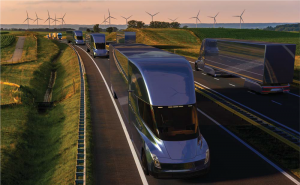 Passenger cars have been leading the way, so far, in the development of zero emission technologies. But there’s also a movement underway to develop heavy-duty electric vehicles – like freight trucks and buses – that could have sweeping benefits for the climate, public health, and American jobs.
Passenger cars have been leading the way, so far, in the development of zero emission technologies. But there’s also a movement underway to develop heavy-duty electric vehicles – like freight trucks and buses – that could have sweeping benefits for the climate, public health, and American jobs.
At EDF, we just released a new report, Clean Trucks, Clean Air, American Jobs, that analyzes the effects of eliminating tailpipe pollution from those medium and heavy-duty vehicles – including buses, semis and other long-haul trucks, and the “last-mile” trucks that deliver packages to American homes.
Our report found that a rapid transition to zero-emitting freight trucks and buses will significantly reduce dangerous air pollution – pollution that disproportionately burdens lower income neighborhoods and communities of color.
Air pollution standards that ensure all new heavy-duty trucks and buses sold for urban and community use are zero-emitting by 2035, and all such vehicles sold are zero-emission by 2040, would:
- Prevent a sum total of more than 57,000 premature deaths by 2050
- Eliminate a sum total of more than 4.7 billion metric tons of climate pollution by 2050.
- Significantly reduce two main components of smog – nitrogen oxides pollution by a sum total of more than 10 million tons by 2050, and particulate pollution by a sum total of almost 200,000 tons by 2050
- Save $485 billion in health and environmental benefits alone as a result of pollution reductions.
Heavy-duty trucks and buses are a major source of the unhealthy air pollution that puts all Americans at risk, with the health burden disproportionately impacting people of color and lower income families. More than 20,000 Americans die prematurely each year as a result of motor vehicle pollution on our roads and highways.
Heavy-duty trucks and buses are only about four percent of all vehicles on our roads, but they are the largest contributor to oxides of nitrogen pollution and particulate pollution of all highway vehicles. People who live closest to our nation’s roads, highways, ports, freight depots and distribution centers face the greatest health risks from that pollution.
America’s heavy-duty trucks and buses are also responsible for more than 420 million tons of climate pollution each year – more than the entire country of Australia.
Momentum is quickly building for a transition to clean trucks in the medium and heavy-duty sector. The Biden campaign set a goal that all new buses be zero emissions by 2030, and major truck manufacturers including Daimler, Volvo, Cummins, General Motors, and Ford are investing in clean technologies and setting targets to eliminate tailpipe pollution by mid-century. Large shipping companies, including Walmart, Amazon and Ikea, have started switching their fleets to zero-emission freight trucks. Another recent report, which EDF commissioned from MJ Bradley and Associates, documents the market trends towards zero-emitting freight trucks and buses.
Getting clean freight trucks on our roads is one of the most important things we can do to protect our health, climate and economy.
You can read the full Clean Trucks, Clean Air, American Jobs report here.









